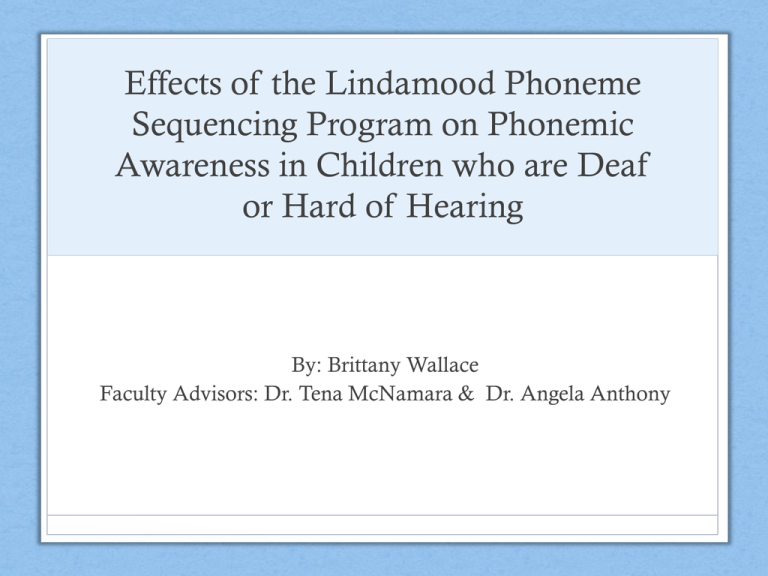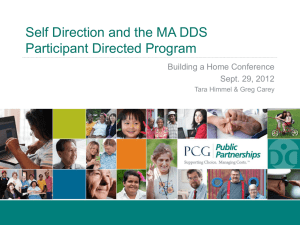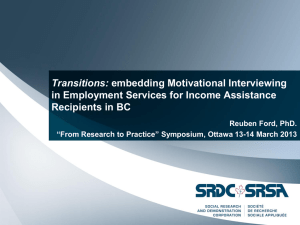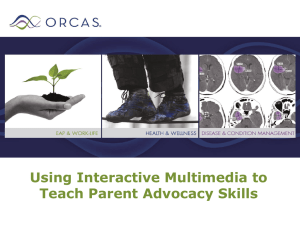Effects of the Lindamood Phoneme Sequencing Program on
advertisement

Effects of the Lindamood Phoneme Sequencing Program on Phonemic Awareness in Children who are Deaf or Hard of Hearing By: Brittany Wallace Faculty Advisors: Dr. Tena McNamara & Dr. Angela Anthony Review of Literature • Liberman, Shankweiler, Fischer, and Carter (1974) defined phonemic awareness as the ability to focus on and manipulate individual phonemes in spoken words • Isolation, identification, blending, segmentation, deletion • Recent studies have found a strong correlation between the presence of phonemic awareness skills and early literacy skills (Ball & Blachman, 1991; Chall, 1996; Ehri et al, 2001; Trezek, Wang, & Paul, 2010) • Successful readers are able to make associations between graphemes printed on the page and their corresponding sounds. The reader is then able to blend those sounds together, understand the word as a whole, and attach meaning in order to comprehend the text (Adams, 1990). • Phonemic awareness skills are prerequisite to comprehension of text and decoding (Trezek et al., 2010) Review of Literature • Understanding that letter symbols represent speech sounds, and the ability to understand the relationship between sound and letter sequences in words are the foundations for becoming an efficient, independent reader. • Chall (1996) describes a six-stage model of reading development. • • • • • • Pre-Reading (6 months – 6 years) Initial Reading and Decoding (6 – 7 years) Confirmation and Theory (7 – 8 years) Reading for Learning (8 – 11 years) Multiple Viewpoints (high school) Construction and Reconstruction (post-high school) Review of Literature • “Hearing impairment is a generic term referring to all types, causes, and degrees of hearing loss,” (Trezek et al., 2010) • Degree determined by Pure Tone Average • Children with hearing impairment may not acquire literacy skills at the same age, or same rate, as a typically developing child. However, it can be said that they still possess the capabilities to progress through the stages of reading development (Trezek, Wang, & Paul, 2010). • Wolk and Allen (1984) found that the average high school graduate who is deaf reads at the fourth to fifth grade level. This study also found the growth in reading achievement of hearing impaired students was only one-third that of average hearing students. • Children who are DHH struggle with specific components of language, particularly morphology and syntax (Trezek, Wang, & Paul, 2010). • Do not receive sufficient auditory models during crucial language learning periods • Struggle to hear high frequency sounds which adversely affects language Review of Literature • Description of the LiPS-3 (Lindamood & Lindamood, 1998) • Designed to target underlying sensory-cognitive functions of reading, spelling, and speech • Targets skills and fosters understanding of phoneme characteristics in emergent-level readers • Introduces sounds in pairs or “brothers” based upon phoneme characteristics such as place, manner, and voicing. • Tip Tappers, Tongue Scrapers, Lip Coolers, Tongue Coolers, Skinny Air, Fat Air, Fat-Pushed Air, Nose Sounds, Wind Sounds, and Lifters. • Vowels introduced in groupings based on lip shape during production • Smile, Open, Round, Sliders • Horizontal and vertical tracks of progression through program Review of Literature • Research supporting LiPS-3 • Several studies have confirmed the direct correlation between teaching phonemic awareness and increased reading abilities (McBride, 2006, Wang, Trezek, Luckner, & Paul, 2008, Nielsen & Luetke-Stahlman, 2002) • What Works Clearinghouse (2010) concluded that the LiPS-3 has potentially positive effects • A study by McIntyre et al. (2008) found greatest gains in phonemic awareness and letter/sound correspondence for ‘at risk’ students whose teacher used the LiPS-3 • Results of a study by Colon (2006) revealed positive average gains by all students on all subtests following the integration of the LiPS-3 into the classroom curriculum. • Pokorni et al. (2004) evaluated the efficacy of three phonemic awarenessbased programs (Fast ForWord, Earobics, and LiPS-3) and found the LiPS3 to be more effective in improving participants’ ability to blend phonemes and significant gains in phonemic awareness. Research Questions • Is the Lindamood Phoneme Sequencing Program – 3rd Edition (LiPS-3) an effective intervention program for improving phonemic awareness skills in children who are deaf or hard of hearing? • Specifically, to what extent did phonemic awareness skills improve as a result of intervention using the LiPS-3? Participants • Participant A • 9-year, 10-month old female • Congenital severe bilateral sensorineural hearing loss • Loss ranging from 70-85 dB • Speech Recognition Test scores of 60 dB • Uses bilateral, behind-the-ear hearing aids • Speech and language difficulties consistent with hearing loss. • Grade 1 reading level (Rigby PM Benchmark Kit) Participants • Participant B • 10-year, 2-month old male • Moderate bilateral hearing loss • Uses bilateral, behind-the-ear hearing aids • Speech and language difficulties consistent with hearing loss. • Grade 1 reading level (Rigby PM Benchmark Kit) Methodology • Research Design • Multiple case study • Pretest – posttest design • Intervention and control phases • Pre- and Posttest Measures • Pretest, midtest, posttest • Phonological Awareness Test -2 (PAT-2) • Lindamood Auditory Conceptualization test (LAC) Methodology • Treatment Protocol • Lindamood Phoneme Sequencing Program – 3rd Edition (LiPS-3) • Direct instruction twice weekly for 40 minutes each session for a total of 7 weeks • Intervention and control phases • Additional practice and review materials provided to classroom teacher • 11 consonant pairs, 4 vowel formations LiPS-3 • Consonants • • • • • • • • • • • Lip Poppers /p, b/ Tip Tappers /t, d/ Tongue Scrapers /k, g/ Lip Coolers /f, v/ Tongue Coolers /;, ‘/ Skinny Air /s, z/ Fat Air /c, x/ Fat-Pushed Air /., j/ Nose Sounds /m, n, a/ Wind Sounds /w, wh/ Lifters /r, l/ • Vowels • • • • Round /u,7,o/ Smile /I,8,2,3,q,4/ Open /0,9/ Sliders /0],o[,9]/ Results – Participant A Figure 1. Participant A: PAT-2 Phonological Awareness Portion Totals 140 116 120 100 86 80 63 60 40 20 0 Pre-test Mid-test Post-test Results – Participant A Figure 3. Participant A: PAT-2 Segmentation Subtest Totals Figure 2. Participant A: PAT-2 Isolation Subtest Totals 30 25 20 15 10 5 0 25 25 20 Pre-test Mid-test 30 25 20 15 10 5 0 20 20 15 11 19 12 Pre-test Post-test Figure 5. Participant A: PAT2 Blending Subtest Totals 25 24 Mid-test 10 Figure 6. Participant A: PAT-2 Deletion Subtest Totals 15 5 5 0 11 13 Mid-test Post-test 25 11 12 Pre-test Mid-test 9 10 6 5 Post-test Figure 7. Participant A: PAT2 Substitution Subtest Totals 7 8 4 4 2 0 0 Pre-test 28 24 20 16 12 8 4 0 Post-test 10 12 Figure 4. Participant A: PAT-2 Rhyming Subtest Totals Pre-test Mid-test Post-test Pre-test Mid-test Post-test Results – Participant A Figure 8. Participant A: LAC Totals 70 64 60 51 50 37 40 30 20 10 0 Pre-test Mid-test Post-test Results – Participant B 90 Figure 9. Participant B: PAT-2 Phonological Awareness Portion Totals 77 80 70 60 60 52 50 40 30 20 10 0 Pre-test Mid-test Post-test Results – Participant B Figure 10. Participant B: PAT-2 Isolation Subtest Totals 25 16 15 15 15 15 13 13 13 Post-test 15 12 8 6 8 6 5 2 0 0 0 Mid-test Post-test 4 5 Pre-test Mid-test Post-test Pre-test Figure 14. Participant B: PAT-2 Substitution Subtest Totals 6 10 0 Pre-test Figure 13. Participant B: PAT-2 Deletion Subtest Totals 12 5 0 Mid-test 16 10 5 Pre-test 20 15 12 10 12 10 20 20 14 Figure 12. Participant B: PAT-2 Rhyming Subtest Totals Figure 11. Participant B: PAT-2 Segmentation Subtest Totals Pre-test Mid-test Post-test Mid-test Post-test Figure 15. Participant B: PAT-2 Blending Subtest Totals 12 10 8 6 4 2 0 7 Pre-test 9 Mid-test 10 Post-test Results – Participant B Figure 16. Participant B: LAC Totals 60 52 50 39 40 30 20 20 10 0 Pre-test Mid-test Post-test Comparison Data Discussion • Data collected indicate the positive effects of phonemic awareness following 7 weeks of intervention using the LiPS-3. • Participant A: intervention phase, followed by control phase • Participant B: control phase, followed by intervention phase • Both participants showed an increase in total raw scores on the PAT-2 following direct instruction. • Participant A continued to show increases through the control phase as well, which may indicate generalization and carryover of skills after the intervention phase. • Participant B’s decrease in scores following control phase and 25 point gain in scores after direct instruction indicates the positive effect of the LiPS-3 on phonemic awareness. Discussion • Both participants demonstrated largest gains on the Segmentation subtest, with gains of 7 and 8 and gains of 6 on the Deletion subtest of the PAT-2. • These results indicate the LiPS-3 had the largest impact on the ability to section a word into its individual sounds and the ability to remove phonemes from a given word to achieve a novel word. • Other largest gains were recorded for the Isolation subtest for participant A and Deletion and Substitution subtest for participant B. • This trend indicated the program also had a positive impact on the ability to identify single phonemes within a word or syllable and the ability to alter a word by deleting or substituting phonemes to create a new word. Discussion • Participant B displayed a 13-point gain on the LAC immediately following direct instruction with the LiPS3. However, a 19-point gain was made over the control phase. • Participant A failed to make any gains on the LAC immediately following the intervention phase, although gains were made following the control phase. • Results from the LAC test are inconclusive and reveal that this assessment may not be an adequate measure of progress for the LiPS-3. Clinical Implications • The LiPS-3 may be an effective intervention program for improving phonemic awareness skills in children who are deaf or hard of hearing • Further research and empirical evidence will assist in solidifying role the LiPS-3 as in the improvement of phonemic awareness skills. Strengths & Limitations • Strengths • Intervention and test administration reliability • Study design • Limitations • • • • Irregular participant attendance Inconsistent use of amplification Small sample size & concise intervention period Formal assessment word selection Future Research • Larger sample • Longer intervention phases • More assessment options • Teacher observation • Behavioral observation • Decoding formal assessment • Further into sequence • Hearing aid vs. cochlear implant • Supplemental visual phonics References Adams, M. J. (1990). Beginning to read: Thinking and learning about print. Cambridge, MA: The MIT Press Ball, E. W., & Blachman, B. A. (1991). Does phoneme awareness training in kindergarten make a difference in early word recognition and developmental spelling? Reading Research Quarterly, 26, 49-66. doi: http://www.jstor.org/stable/747731 Chall, J. S., (1996). Stages of reading development. (2nd ed.). New York: McGraw-Hill. Colon, E. (2006). Utility of the Lindamood Phoneme Sequencing Program (LiPS) for classroom-based reading instruction. Dissertation Abstracts International Section A, 67. Ehri, L. C., Nunes, S. R., Willows, D. M, Schuster, B. V., Yaghoub-Zadeh, Z., & Shanahan, T. (2001). Phonemic awareness instruction helps children learn to read: Evidence from the National Reading Panel’s meta-analysis. Reading Research Quarterly, 36, 250-287. doi: http://www.jstor.org/stable/748111 Liberman, I., Shankweiler, D., Fischer, F., & Carter, B. (1974). Explicit syllable and phoneme segmentation in the young child. Journal of Experimental Child Psychology, 18, 201-212. doi: 10.1016/0022-0965(74)90101-5 Lindamood, C. H., & Lindamood, P. C. (1998). Lindamood Phoneme Sequencing Program. Austin, TX: PRO-ED References McIntyre, L., Protz, S., & McQuarrie, L. (2008). Exploring the potential of LiPS instruction for beginning readers. Developmental Disabilities Bulletin, 36(1-2), 18-48. McBride, N. (2006). The effectiveness of second shot and/or Lindamood-Bell on reading achievement of elementary students. Dissertation Abstracts International Section A, 67. Pokorni, J. L., Worthington, C. K., & Jamison, P. J. (2004). Phonological awareness intervention: Comparison of Fast ForWord, Earobics, and LiPS. The Journal of Educational Research, 97(3), 147-158. doi: 10.3200/JOER.97.3.147-158 Trezek, B. J., Wang, Y., & Paul, P. V. (2010). Reading and deafness: Theory, research, and practice. Clifton Park, NY: Delmar, Cengage Learning. Wang, Y., Trezek, B. J., Luckner, J. L., & Paul, P. V. (2008). The role of phonology and phonologically related skills in reading instruction for students who are deaf or hard of hearing. American Annals of the Deaf, 153, 396-407. What Works Clearinghouse. (2010). Lindamood Phoneme Sequencing (LiPS). What Works Clearinghouse Intervention Report. What Works Clearinghouse. Wolk, S., & Allen, T. E. (1984). A 5-year follow-up of reading comprehension achievement of hearing-impaired students in special education programs. The Journal of Special Education, 18, 161-176. Questions?






